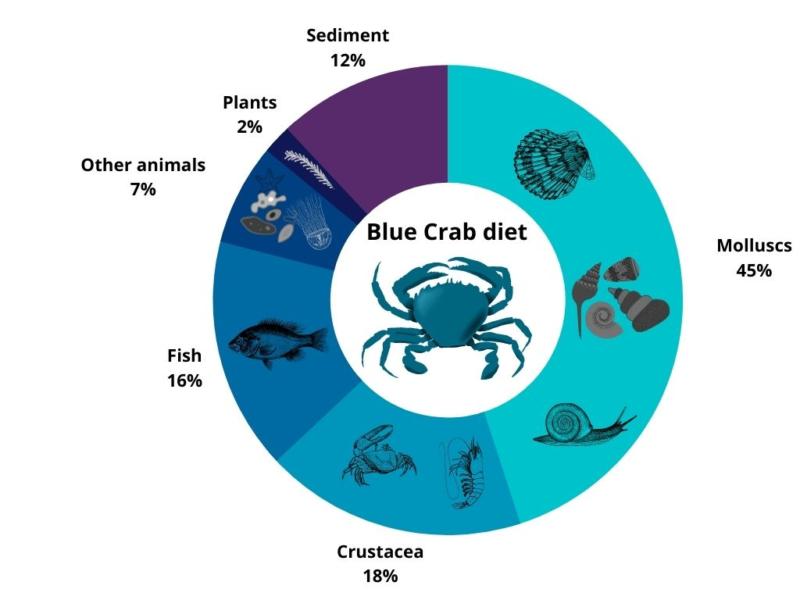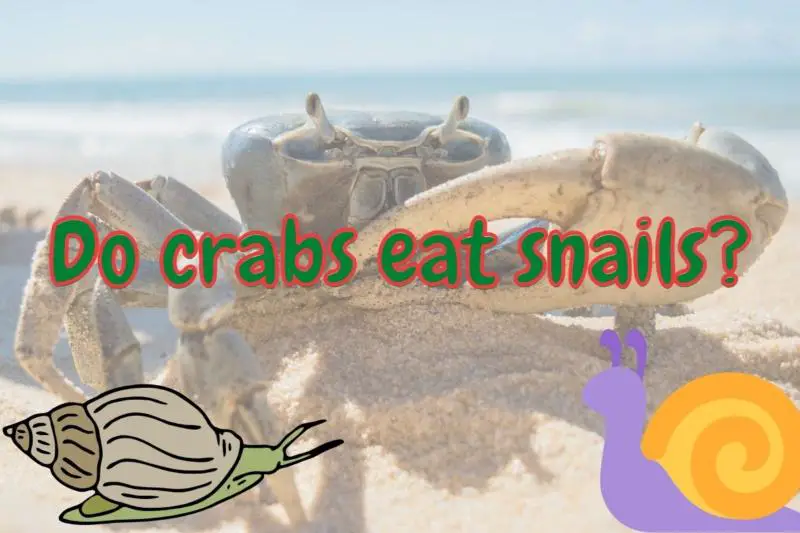Crabs are omnivorous animals belonging to the taxon of Crustacea that includes other shellfish such as lobsters, crayfish, shrimp, and prawns.
Most crabs love to eat snails and other molluscs. For some crabs like the blue crab and Horseshoe crabs, snails, clams and other molluscs make up more around half of their diet. Hermit crabs often eat snails to take over their shell.
Crabs are likely to be the animals within Decapoda with the largest appetite for snails and other molluscs. If we compare to for example their crayfish cousins, crabs seem to prefer molluscs above most other food items.
Snails and slugs are gastropods and snails are the gastropods that carry a shell. Sea snails are characterized by carrying a shell and living underwater – and these are the ones most often preyed upon by crabs!
Just as the marine snails, marine crabs spend most of their time at the bottom of the sea seeking out prey. Therefore they inevitable come into contact and because a hungry crab is not a picky eater, it will defiantly eat most snails and slugs it encounters.
While crabs do eat algae and plant material, they do need a lot of protein and the optimal crab diet includes more than 30% protein. As snails are rich in protein, they are preferred dietary items for crabs.
A study by Armitage and Fong from 2006 reports that the striped shore crab, a relatively small crab species found widely across North America, would eat up to 85% of California horn snails that were present in the same habitat.
The authors tested two different setups: one where the sea bed was mostly made of sand and one where it mostly consisted of mud.
In both sand and mud, the crabs would eat a significant portion of the snails, although they were more likely to eat the snails when on the sand.
The reason for doing studies into snail predation by crabs is that it teaches us about the influence each species have on each other and on the wider ecosystem.
For example, when many crabs are present among snails, the snails tend to burry themselves in the sand to hide from the crabs. This in turn gives the snails less time to forage for food themselves, and thus increases the presence of other species such as the algae the snails feed on.
Contents
What crabs eat sea snails?
Almost any aquatic crab will eat a dead or dying snail if it gets the chance. However, there are differences in food preferences between crabs including their ability to catch different prey.
Whereas larger crabs can eat larger snails on average, smaller crabs generally don’t take on larger living snails (but there are exceptions – see below).
Some crabs are more inclined to attack and eat snails than others. For example, hermit crabs are dependent on snails for their shell, so they may attack snails for that purpose. But not all hermit crabs will eat snails solely from a nutrient point of view.
Hermit crabs do not normally attack snails for food, but mostly acquire their shell from already dead snails.
However, larger hermit crabs such as the Large Hairy Yellow Hermit Crab (yep that’s its name!) and the giant Petrochirus diogenes hermit crab species found in the Caribbean will attack marine snails, eat the snail themselves and steal their shell.
Do blue crabs eat snails?
Snails do make up a significant part of the blue crab diet and are, along with other molluscs, the main constituents for most blue crabs. The rest of their diet consists mostly of other crabs and fish.
Being bottom dwellers, blue crabs do indeed encounter snails and are big enough to handle even larger snails.
The amount of snails that a blue crab eats obviously depends on the exact habitat and climate.

Do emerald crabs eat snails?
As other crabs, emerald crabs are opportunistic eaters and will eat snails if they get the chance. Being a popular pet in aquariums, there are reported cases of emerald crabs eating snails kept in the same enclosure.
This includes vermetid snails and turbo snails, but happens mostly if the emerald crab is not well fed or if the snail is dead.
Do freshwater crabs eat snails?
Because freshwater crabs are largely omnivores, they will readily eat other animals including snails, especially if held in captivity and other food options are limited.
Studies have shown that while larger freshwater crabs live mostly from plant material, it is actually the smaller crabs that tend to hunt down other animals for food. This is thought to be due to the increased agility of smaller freshwater crabs compared to larger ones.
Freshwater crabs such as the Fiddler Crab, the Freshwater Pom Pom Crab, the Vampire Crab and the Panther Crab are often kept in fish tanks and will eat co-residing snails if starved.
While most crabs eat a varied diet there are freshwater crabs that mainly eat snails. The best known example is the Platythelphusa armata crab species native to the Lake Tanganyika in south east Africa.
It lives almost exclusively on specific freshwater snails found in Lake Tanganyika and is thought to do so because of their sheer abundance in the lake.
Interestingly, it is believed that the immense arms race between the snail feeding Platythelphusa crab species and the freshwater snails species of Lake Tanganyika have lead to the vast diversity of more than 83 different snails species.
Some of these snails have evolved extra thick shells, a trait that has been suggested to be a response to high frequency of predation by the freshwater crabs in the lake.
Can crabs and snails live together in a fish tank?
Yes. But the answer really depends on the crab species and the snails you would like to keep in your aquarium.
As described for the crabs species mentioned above, some crabs feed almost exclusively on snails and these should therefore not be expected to leave your decorative aquarium snails alone.
However, many smaller hermit crabs will do fine around snails if they are well fed and have access to plenty of other (empty!) shells to house themselves in during their different growth stages.
For example, if a hermit crab eats snails and kills them for their shells, you must provide the hermit crab with appropriate shells. If the hermit crab simply kills the snail for food, you should consider providing more feed or more interesting food options for your shelled crab friends.
The interior and size of you aquarium is also important. You need to make space for both crabs and snails, so that they don’t constantly bump into one another.
This can be done with hiding places in mind, so that you choose your rocks, plants and other objects with cavities and holes that allows for your snails to hide when needed.
Also, when you choose the snails and crabs for your fish tank, make sure that the shells of each part do not look too much alike. Hermit crabs will often choose shells that look like the ones they already have therefore, the more different in looks (especially size!) you can select your snails shell, the better.
Would snails eat crabs?
Surprisingly, yes! There are snails that eat crabs.
So you might think that snails are harmless to crabs due to their soft slimy appearance? Think again! There are definitely snails that are quite aggressive towards crabs out there.
Surely snails may eat dead decomposing crabs they pass by on their way, but what about living crabs?
A study by T. Huelsken presented the fist data on a shell drilling Australian moonsnail attacking, killing and completely devouring a soldier crab. See the video here!
Australian moon snail (Conuber sordidus) are predatory snails that normally feed by drilling through the shell of snails and other mollusks, but occasionally manages to overpower a crab or two.
They initiate their attack by coating the crab with mucus, making it harder for the crab to escape after which they drill a hole in the shell of their prey to access their soft tissues. It was first thought that the holes found in crab shells would stem from octopus attacks but were later discovered to be the work of shell drilling snails as well.
Shell drilling snails will sometimes attack hermit crabs, which may be out of confusion with other snails that comprise their main prey. However, the drilled holes found in the soldier crabs do not resemble other snails and therefore seems like a deliberate attack on a crab.
Further readings
If you are interested in crab diets, I have written an overview article including all the most common food items of more than 10 types of crabs here.
Other external sources, mostly books and scientific papers that I get my information from, can be found below.
Sources
Armitage and Fong. Predation and physical disturbance by crabs reduce the relative impacts of nutrients in a tidal mudflat. Marine Ecology Progress Series 2006.
FRESHWATER CRABS IN AFRICA by MICHAEL DOBSON. Freshwater Biological Association 2004.




